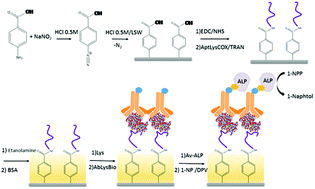A novel electrochemical aptamer–antibody sandwich assay for lysozyme detection
Abstract
In this paper, we have reported a novel electrochemical aptamer–antibody based sandwich biosensor for the detection of lysozyme. In the sensing strategy, an anti-lysozyme aptamer was immobilized onto the carbon electrode surface by covalent binding via diazonium salt chemistry. After incubating with a target protein (lysozyme), a biotinylated antibody was used to complete the sandwich format. The subsequent additions of avidin-alkaline phosphatase as an enzyme label, and a 1-naphthyl phosphate substrate (1-NPP) allowed us to determine the concentration of lysozyme (Lys) via Differential Pulse Voltammetry (DPV) of the generated enzyme reaction product, 1-naphthol. Using this strategy, a wide detection range from 5 fM to 5 nM was obtained for a target lysozyme, with a detection limit of 4.3 fM. The control experiments were carried out by using bovine serum albumin (BSA), cytochrome c and casein. The results showed that the proposed biosensor had good specificity, stability and reproducibility for lysozyme analysis. In addition, the biosensor was applied for detecting lysozyme in spiked wine samples, and very good recovery rates were obtained in the range from 95.2 to 102.0% for lysozyme detection. This implies that the proposed sandwich biosensor is a promising analytical tool for the analysis of lysozyme in real samples.


 Please wait while we load your content...
Please wait while we load your content...